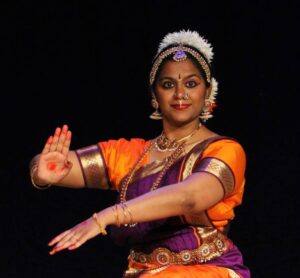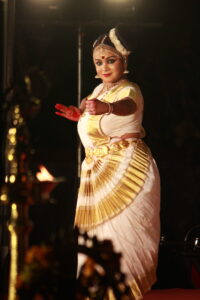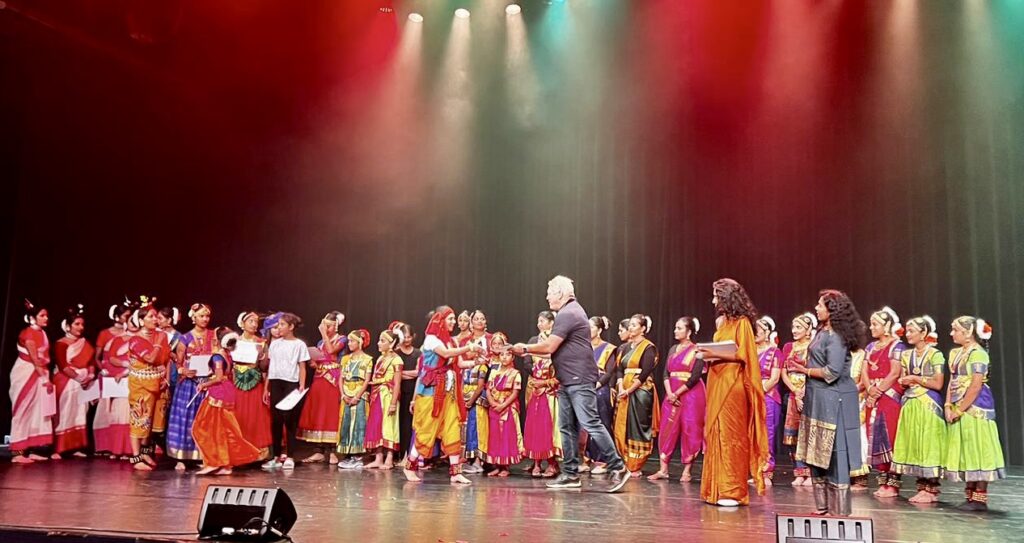The Veldhoven City Fest focuses on connections between the various communities and generations living in Veldhoven. The three-day free festival offered activities on various locations: Museum ‘t Oude Slot, the Veldhoven library and ART4U Art Education. and D’Ekkerplein. De Schalm Theatre hosted an Indian dance festival, India in Focus, which brought together amazing talent from various dance schools.
After the mayor of Veldhoven, Marcel Delhez had emphasised the value of intercultural connections in his address, the stage became the focus of a series of rich, colourful, graceful, spiritual and enticing performances. Exciting or dreamy rhythms, stunning costumes and talented and dedicated dancers in a riot of colour and movement showcased the strong bond the dancers have with their vibrant cultural and spiritual heritage. Beena Arunraj, the organiser, is thrilled and “thankful for the opportunity to share the cultural glory of India with the Veldhoven people.”
Classical and folk
Of the eight recognised Indian classical dances, India in Focus presented five. They were performed by professional talent in the Netherlands. India in Focus also
presented folk dances of India, such as Karagattam, Oyilaatam,
Thappattam, Kolaatam, Bihu, Santhal and Kuthattam.
Classical dance forms
Odissi from the east

Odissi is indigenous to Orissa in eastern India. It is predominantly a dance for women, with postures that replicate those found in temple sculptures. Based on archaeological findings, Odissi is believed to be the oldest of the surviving Indian classical dances. Odissi is a complex and expressive dance, with over fifty mudras (symbolic hand gestures) commonly used.
Bharatanatyam from the south
 Bharathanatyam is a dance of Tamil Nadu in southern India. It traces its origins back to the Natyashastra an ancient treatise on theatre written by the mythic priest Bharata. Originally a temple dance for women, Bharatanatyam is often used to express Hindu religious stories and devotions. It was not commonly seen on the public stage until the 20th century. The dance movements are characterised by bent legs, while feet keep rhythm. Hands may be used in a series of mudras to tell a story.
Bharathanatyam is a dance of Tamil Nadu in southern India. It traces its origins back to the Natyashastra an ancient treatise on theatre written by the mythic priest Bharata. Originally a temple dance for women, Bharatanatyam is often used to express Hindu religious stories and devotions. It was not commonly seen on the public stage until the 20th century. The dance movements are characterised by bent legs, while feet keep rhythm. Hands may be used in a series of mudras to tell a story.
Kathak from the north
A dance of northern India, Kathak is often a dance of love which both men and women perform. The movements include intricate footwork accented by bells worn around the ankles and stylised gestures adapted from typical body language. It was originated by
Kathakas, professional storytellers who used a mixture of dance, song, and drama. Like other Indian dances, it began as a temple dance but soon moved into the courts of ruling houses.
Mohiniyattam
 Mohiniattam dance gets its name from the word Mohini – a historical enchantress avatar of the Hindu God Vishnu, who helps good prevail over evil by developing her feminine powers. The basic posture of Mohiniyattam is parted feet, knees bent outwards, an erect upper torso, and gentle 8-shape side-to-side swaying of the body along with hips (Ati Bhanga). The footwork is soft, sliding and synchronous with the musical beat and acting. The body movement is sometimes described in terms of calming images of nature, such as the swinging of the palm leaves and the gentle undulating of ocean waves.
Mohiniattam dance gets its name from the word Mohini – a historical enchantress avatar of the Hindu God Vishnu, who helps good prevail over evil by developing her feminine powers. The basic posture of Mohiniyattam is parted feet, knees bent outwards, an erect upper torso, and gentle 8-shape side-to-side swaying of the body along with hips (Ati Bhanga). The footwork is soft, sliding and synchronous with the musical beat and acting. The body movement is sometimes described in terms of calming images of nature, such as the swinging of the palm leaves and the gentle undulating of ocean waves.
Andhranatyam

This dance form dates back 2000 years and is predominantly from Andhra Pradesh. This is a temple classical dance mainly performed by women. The practice of this dance form was discontinued for several centuries and was revived in the 1970’s. Andhranatyam includes beautiful, delicate body movements with graceful gestures and slenderness of the Kaisiki Vritti, performed by female artists.
Indian folk dances
Karagattam
The most important feature of this dance form is the ‘karagam’ on the heads of the dancers. Karagam translates roughly as a water pot. Ancient Tamil epic indicates that this type of dance is derived from Bharatham and a mixture of multiple forms of Tamil dance forms like Bharatanatyam postures and mudras. The offering of this dance is to the rain goddess Mariamma.
Oyilattam
The word literally means dance of grace and is a folk dance with origins in the south Tamilnadu region. Men perform this, holding a colourful piece of cloth in both their hands. The beauty of this dance form is in the graceful and synchronous movement. In the last century, women have also started practising this craft.
Bihu
The Bihu dance is an indigenous folk dance from the Indian state of Assam related to the Bihu festival and an important part of Assamese culture. Performed in a group, the Bihu dancers are usually young men and women, and the dancing style is characterised by brisk steps and rapid hand movements.
Kolattam
Kolattam is an ancient village art. It could also be called ‘the stick dance’. This is indigenous to South India. ‘Kol’ means stick in Tamil, Telugu and Kannada. Kolaatam is performed by women with two sticks in each hand, creating a rhythmic sound.
Santhal
This is tribal folk dance, which displays the rich cultural heritage of the tribe. This dance form is from the eastern part of India, namely Bengal and Jharkhand. Santhal is generally
performed by both men and women. The dancers form a circle or semi-circle. The male and female dancers dance in separate rows in sequence, with their arms interlocked.
Kunbi
Kunbi tribes were the earliest settlers of Goa which was a Portuguese colony previously. Though the members of this community converted to Christianity under the influence of the Portuguese colonial rule, they still maintain their centuries-old non-Christian traditional
dance like the Kunbi dance. This is a wonderful example of preserving religious and social harmony even in contradictory situations.

For Eindhoven News: Greta Timmers
Source: De Schalm & India in Focus
















